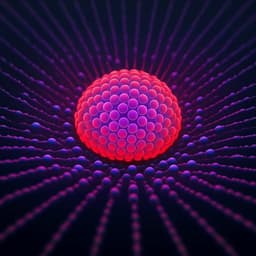
Chemistry
When quantum dots meet blue phase liquid crystal elastomers: visualized full-color and mechanically-switchable circularly polarized luminescence
S. Li, Y. Tang, et al.
Discover how researchers Shan Li, Yuqi Tang, Qingyan Fan, Ziyuan Li, Xinfang Zhang, Jingxia Wang, Jinbao Guo, and Quan Li have pioneered full-color circularly polarized luminescence (CPL) materials using innovative polymer-based techniques. Their work utilizing reconfigurable blue phase liquid crystal elastomers demonstrates remarkable potential in anti-counterfeiting and information encryption applications.
~3 min • Beginner • English
Introduction
The study addresses the challenge of precisely tuning circularly polarized luminescence (CPL) in polymer-based materials by leveraging blue phase liquid crystal elastomers (BPLCEs). CPL-active materials are important for sensing, encryption, optical storage, and other photonic applications, with performance quantified by the luminescence dissymmetry factor g_lum. Conventional strategies using cholesteric liquid crystals (CLCs) can amplify g_lum but typically require precise matching between the photonic bandgap (PBG) and the emitter’s spectrum and are often constrained to LC cells, limiting practical use. Polymer liquid crystal systems offer better processability and stability, but CPL tunability remains difficult due to challenges in controlling chiral structures. Blue phase LCs, possessing 3D cubic lattices and strong chiral environments, present a promising route. This work proposes and demonstrates BPLCE-based solid CPL systems doped with red/green/blue (RGB) quantum dots to realize visualized full-color, high-g_lum CPL that is independent of PBG-emission matching and is mechanically switchable.
Literature Review
Prior work has shown that cholesteric liquid crystals (CLCs) with helical superstructures effectively amplify CPL (high g_lum) and respond to various stimuli, enabling responsive CPL systems. Examples include AIE-active tetraphenylethylene in CLC polymers to enhance fluorescence and polyether-based CLC copolymers exhibiting strong CPL with dye incorporation. However, polymer CLC films often have limited stimulus responsiveness in the solid state due to frozen helices, and achieving high g_lum typically requires precise alignment between emission and reflection bands via careful chiral dopant tuning. Blue phase LCs (BPs) self-assemble into double-twist cylinders forming 3D cubic lattices (BPIII, BPII, BPI) with photonic properties in the visible range and inherent responsiveness to multiple stimuli. BPLC elastomers (BPLCEs) combine chiral photonic structures with elastomeric networks and deformability, suggesting they could overcome limitations of CLC-based systems by providing a narrower PBG and stronger chiral environment for CPL amplification without strict PBG-emitter matching.
Methodology
- Materials and synthesis: Prepared freestanding QD-doped BPLCE films via one-step in situ photopolymerization of acrylate monomers with dithiol. LC monomers: RM82 and RM105; chiral dopant: LC756; thiol crosslinker: benzenedimethanethiol (BDMT); disulfide diacrylate crosslinker: disulfanediylbis(ethane-2,1-diyl) diacrylate (DSDA), synthesized from bis(2-hydroxyethyl) disulfide and acryloyl chloride; photoinitiator: I-651; emitters: oil-soluble quantum dots (QDs) with red (625 nm), green (525 nm), and blue (465 nm) emission.
- Film fabrication: Precursor mixtures infiltrated into LC cells, cooled to form BPI, then UV-cured at 28.0 °C under 365 nm for 5 min (30 mW cm^-2). QDs preferentially localized along disclination lines in BPI. Five QD-BPLCE variants were prepared by adjusting chiral content and QD type: R-G-BPLCE, G-G-BPLCE, B-G-BPLCE, G-R-BPLCE, G-B-BPLCE.
- Structural and thermal characterization: Polarized optical microscopy (POM) verified BPI textures; Kossel diagrams showed BPI [110] diamond pattern; TEM confirmed BPI [110] orientation with lattice constant ~265.57 nm; SEM/EDS mapping showed uniform QD distribution; HRTEM revealed QD lattice fringes (0.24 nm). DSC determined Tg ≈ 5.0 °C and BP-to-isotropic transition Ti ≈ 140 °C. Temperature-dependent reflection/PL indicated stable signals up to ~80 °C.
- Optical measurements: Reflection spectra and photoluminescence (PL) collected; CPL measured using a CPL-200 spectrometer. Eliminated linear dichroism contributions from macroscopic anisotropy.
- Parameter optimization: Varied QD content (0.1–1.2 wt%) in G-G-BPLCE; maximum g_lum at 0.2 wt% (higher loadings decreased alignment/g_lum). Varied film thickness; CPL maximized at 50 μm thickness, with signal increasing then decreasing versus thickness.
- Comparative control: Prepared a cholesteric LC elastomer (G-CLCE) by polymerizing the same precursor composition at cholesteric phase (22 °C) to compare CPL generation mechanisms.
- Mechanical tests and tuning: Assessed stretchability and modulus (example R-G-BPLCE: max strain ≈ 110%, modulus ≈ 3.7 MPa). Monitored reflection peak shifts under uniaxial strain (e.g., R-G-BPLCE red-to-blue shift Δλ ≈ 160 nm from 625→465 nm at 0–100% strain; G-G-BPLCE shift Δλ ≈ 57 nm from 525→468 nm). Conducted multiple stretch–release cycles (10 cycles) with negligible degradation. Kossel patterns used to track lattice reorientation under strain.
Key Findings
- Full-color CPL: Doping red, green, and blue QDs into BPLCEs yielded robust full-color CPL with strong negative signals across samples (G-R-BPLCE, G-G-BPLCE, G-B-BPLCE).
- High dissymmetry factors independent of PBG matching: Maximum |g_lum| values around 0.7 were achieved irrespective of PBG–emission overlap, indicating CPL in BPLCEs is not governed by selective reflection matching. Reported maxima include g_lum ≈ 0.72 (G-G-BPLCE), 0.74 (G-B-BPLCE), and ~0.70 at optimal QD loading (0.2 wt%).
- Opposite CPL handedness relative to CLCEs: Despite similar negative CD signals (set by right-handed chiral dopant), BPLCEs produced right-handed CPL while CLCEs produced left-handed CPL under comparable conditions. A G-CLCE control showed positive CPL with g_lum ≈ 0.60, whereas BPLCE counterparts showed negative CPL of similar magnitude (e.g., R-G-BPLCE g_lum ≈ −0.74; B-G-BPLCE g_lum ≈ −0.69).
- Mechanism: In CLCEs, selective reflection within the PBG filters CPL, yielding opposite handedness to the helical sense. In BPLCEs, the 3D chiral cubic environment directly induces CPL of a fixed handedness that is largely independent of PBG position.
- Structural confirmation: BPI [110] orientation confirmed by Kossel and TEM; lattice constant ~265.57 nm; QDs localize at disclination lines and are uniformly distributed.
- Mechanical tunability: BPLCE films are highly stretchable (up to ~110% strain) with modulus ~3.7 MPa. Strain induced substantial photonic shifts (e.g., Δλ ≈ 160 nm in R-G-BPLCE; Δλ ≈ 57 nm in G-G-BPLCE) and allowed on–off or tunable CPL behaviors correlated with lattice reconfiguration. Performance retained over at least 10 stretch–release cycles.
- Thermal stability: Fully polymerized networks maintained strong reflectance and fluorescence up to ~80 °C; Tg ≈ 5 °C; BP-to-isotropic transition at ~140 °C.
- Applications: Demonstrated visual anti-counterfeiting and information encryption using QD-BPLCEs; dynamic disulfide bonds enable fixing of mechanically programmed CPL states.
Discussion
The work establishes that blue phase liquid crystal elastomers provide a distinct route to strong CPL generation compared with cholesteric systems. Unlike CLCEs, where high g_lum typically relies on spectral matching to the photonic bandgap and results from selective reflection, BPLCEs exploit their inherently chiral 3D cubic superstructure to induce CPL with high g_lum independent of PBG-emission overlap. This difference is evidenced by opposite CPL handedness between BPLCEs and CLCEs despite similar CD behavior determined by the chiral dopant. The ability to achieve full-color CPL using RGB QDs with comparable g_lum values around 0.7 underscores the robustness of the BPLCE-induced CPL mechanism. Furthermore, the elastomeric network confers mechanical reconfigurability: strain modifies the lattice (tracked by Kossel patterns) and photonic response (large reflection shifts), enabling on–off switching and programmable CPL, which can be fixed via dynamic disulfide chemistry. Collectively, these advances address the challenge of tunable, solid-state CPL materials and highlight practical relevance for secure displays, anti-counterfeiting, and optical information encryption.
Conclusion
This study introduces QD-doped blue phase liquid crystal elastomers as solid-state CPL materials that deliver visualized full-color emission with high dissymmetry (|g_lum| up to ~0.74), independent of photonic bandgap–emission matching. The 3D chiral cubic structure of BPLCEs induces CPL with handedness opposite to that of CLCEs, offering a new mechanism for CPL generation in polymers. The films are elastomeric, enabling reversible mechanical tuning and on–off switching of CPL; dynamic disulfide bonds allow fixation of programmed states. The platform demonstrates promise in anti-counterfeiting and information encryption. Future research could explore broader emitter chemistries and wavelengths, optimize elastomer network composition for durability and higher g_lum, investigate multi-stimuli responsiveness (e.g., electrical, thermal), and integrate BPLCE-based CPL elements into device architectures.
Limitations
- CPL performance depends on QD concentration and film thickness; excessive QD loading impairs LC alignment and reduces g_lum, and CPL shows an optimum at ~50 μm thickness.
- While thermal stability of optical signals is demonstrated up to ~80 °C and mechanical cycling over 10 cycles shows minimal degradation, longer-term durability, fatigue resistance, and environmental stability (humidity, UV exposure) are not fully detailed.
- The mechanism is inferred from optical comparisons and structural characterization; quantitative modeling of CPL induction within the BPI lattice and its dependence on defect/QD distributions could further validate generality.
- Generalizability to other LC compositions, chiral dopants, and a wider range of QD chemistries/sizes remains to be established.
Related Publications
Explore these studies to deepen your understanding of the subject.







